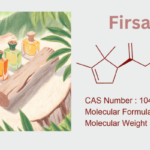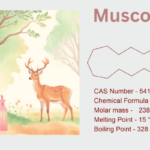1. Introduction: The Essence of Benzyl Acetate
A fundamental component of contemporary perfumes and cosmetics is benzoyl acetate, a straightforward but recognizable ester. This molecule unites synthetic chemistry and nature with its sweet, flowery perfume that is reminiscent of fresh fruits and jasmine. Because of its affordability and adaptability, it is now essential for making beauty products, upscale fragrances, and even household goods. This article provides a thorough examination of the chemical synthesis, natural origins, industrial uses, and crucial role that benzyl acetate plays in fragrance composition, demonstrating why this molecule is still a favorite among perfumers.
2. Synthesis of Benzyl Acetate: Crafting an Ester
Esterification is a traditional chemical reaction that combines an acid and an alcohol to create benzoyl acetate (C₉H₁₀O₂).
Laboratory Synthesis
- Fischer Esterification:
- Reactants: Benzyl alcohol (C₆H₅CH₂OH) and acetic acid (CH₃COOH).
- Catalyst: Concentrated sulfuric acid (H₂SO₄) or hydrochloric acid (HCl).
- Process: The mixture is heated under reflux, facilitating the acid-catalyzed formation of benzyl acetate and water.
- Equation:
C6H5CH2OH+CH3COOH⇌C6H5CH2OCOCH3+H2O
- Acetylation with Acetic Anhydride:
- The acetic anhydride [(CH₃CO)₂O] is used as the acetylating agent in a quicker, higher-yield technique.
- Advantage: Avoids equilibrium limitations of Fischer esterification.
Industrial Production
- Scale-Up: Continuous-flow reactors optimize efficiency and safety.
- Purification: Distillation produces >99% purity by eliminating unreacted acetic acid and benzyl alcohol.
3. Natural Sources: Where Nature Meets Chemistry
Benzyl acetate is found naturally in a variety of plant sources, although being primarily synthetic:
- Jasmine Flowers (Jasminum spp.): Up to 60% of jasmine essential oil.
- Gardenias (Gardenia jasminoides): Contributes to their heady, tropical scent.
- Ylang-Ylang (Cananga odorata): Adds fruity undertones to its complex aroma.
- Apples and Bananas: Trace amounts contribute to their ripe, sweet profiles.
Extraction Methods:
- Steam Distillation: Isolates benzyl acetate from floral oils.
- Solvent Extraction: Used for delicate flowers like jasmine.
4. Uses: Beyond Perfumery
Fragrance Industry:
- Perfumes: Mimics jasmine in Chanel’s No. 5 and Dior’s J’adore.
- Cosmetics: Adds scent to lotions, soaps, and shampoos.
- Candles and Cleaners: Provides a fresh, clean aroma.
Flavoring:
- Foods: FDA-approved as artificial flavoring (apple, pear candies, for example).
- Beverages: Enhances fruity notes in soft drinks.
Industrial Applications:
- Solvent: For plastics, resins, and cellulose.
- Plasticizer: Improves flexibility in polymers.
5. Formulation: Blending Science and Art
The stability and volatility of benzoyl acetate determine its use in formulations:
Perfume Structure:
- Top Note: Evaporates quickly, creating an initial burst of freshness.
- Blending: adds depth by combining with benzyl benzoate (balsamic) and linalool (citrus).
Concentration Guidelines:
- Fine Fragrances: 10–20% in floral accords.
- Cosmetics: 1–5% in lotions; IFRA recommends <5% for skin safety.
Stability Considerations:
- pH Sensitivity: Hydrolyzes to benzyl alcohol in alkaline conditions.
- Packaging: Bottles made of amber glass resist UV deterioration.
6. Fragrance Profile: The Scent of Elegance
Benzyl acetate’s aroma is a harmonious blend of:
- Floral: Dominant jasmine-like character.
- Fruity: Subtle apple and pear nuances.
- Green: Fresh, dewy undertones.
Iconic Applications:
- Single-Note Perfumes: Showcases its purity in soliflores.
- Complex Bouquets: Balances oriental and chypre fragrances.
7. Challenges and Innovations
Sustainability:
- Green Synthesis: • Chemical waste is decreased through the use of lipases in enzymatic esterification.
- Bio-Based Benzyl Alcohol: Derived from lignin or fermentation.
Regulatory Compliance:
- IFRA Standards: restricts leave-on product concentrations to avoid sensitization.
8. Conclusion: The Timeless Appeal of Benzyl Acetate
From its modest origins in a chemist’s flask to its prominent position in well-known fragrances, benzyl acetate is a prime example of how science and nature can work together harmoniously. The versatility of this molecule guarantees its continued significance as the fragrance business shifts toward sustainability and transparency. As perfumer Ernest Beaux once said, “A perfume must tell a story in addition to having a pleasing scent.” With its clear floral story, benzoyl acetate never fails to enchant both noses and imaginations.










